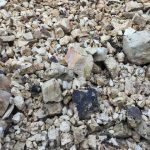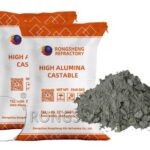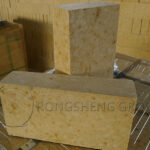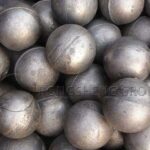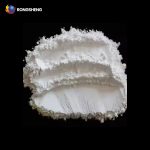The continuous development of materials science is mainly affected by two factors, namely the needs of users and the upgrading of technology. Changes in user industrial patterns and user demand for high-quality products have led to major improvements in the use of refractory materials. So, what factors affect the performance of cement-free high-alumina self-flowing castables? Using different silica sol components as binders, the physical and chemical properties of two high-alumina cementless self-flowing castables with particle size distribution were studied after heat treatment, and some conclusions were drawn. To get free cement-free high-alumina self-flowing castable prices and high alumina castables samples, please contact the refractory manufacturer.
With the development of high-purity and high-alumina cement, in almost all refractory applications, shaped products are changed to monolithic refractories. In order to reduce the content of cement (CaO), the development of castables is slow but stable. The application of castables without external energy (vibration) has been successfully achieved in almost all applications of integral refractory linings.

Important Characteristics of Self-Flowing Refractory Castables
Self-flowing castable (SFC), the product is characterized by a certain consistency after mixing, and it can flow and degas without external energy (vibration). Self-flowing castables can be divided into low cement castables (LCC), ultra-low cement castables (ULCC), and non-cement castables (NCC).
Fluidity is the most important characteristic of self-flowing castables. When refractory aggregates, powders, water, and additives are mixed, they form a flowable viscous component. If this component can flow without the help of external energy, then it can be called a self-flowing castable. The construction of the castable depends on the fluidity of the castable and the time it takes to lose fluidity due to hardening. Loss of fluidity has always been the main problem of refractory castables.
How to Realize the Fluidity of Self-Flowing Castables?
Among various self-flowing castables, cement-free castables are technically important. The cement-containing artesian technology mainly adjusts the particle size distribution. The cement in the castable acts as a fine filler and binder, so no cement will affect the characteristics of the castable. Therefore, it is necessary to use a suitable binder (such as sol) in cementless castables, and carefully adjust the particle size distribution to provide close packing between particles to obtain higher strength without affecting flow.
Generally speaking, refractory manufacturers want to obtain a dense structure. However, for castables, due to the need for fluidity, density and fluidity must be considered comprehensively (easy to construct). Adding water improves fluidity, but creates a structure with pores. In theory, 100% density can be expected, but it is a contradiction to liquidity.
Flow is the effect of particles moving between each other. The 100% bulk density prevents the particles from moving, thus hindering the flow. Therefore, for castables, particle size distribution is important for bulk density and flow characteristics, and it ultimately determines the ease of application. Using sol to replace cement binder is a new method in the field of refractory materials. Among various cement-free binders, various sols (including silica, alumina, magnesia, and zirconia) have been studied. Because of its relatively easy production and high stability, silica sol has been widely recognized. The silica sol binder is composed of nano-sized colloidal silicon particles dispersed in an alkaline medium.
The alkaline medium generates negative charges on the silicon particles, repels each other, and generates stability. Due to the presence of positively charged ions (Na+ or NH4+) or changes in pH (evaporation of water), when the repulsive effect is weakened, the sol turns into a gel. During this process, the hydroxyl groups on the surface of the particles solidify and remove water to form a Si-O-Si bond, resulting in glue and bond.

What Factors Affect the Performance of Cement-Free High-Alumina Self-Flowing Castables?
The effect of the particle size distribution (two different particle sizes) on the self-flowing (without vibration) and other physical and chemical properties of high-alumina (Al2Os> 90%) cementless castables. For the castable with the best sol (binding agent) content, its various properties, including bulk density, apparent porosity, normal temperature compressive strength, load softening point, permanent linear change, peeling resistance, and high-temperature flexural strength, also have a certain impact.
Factors affecting the characteristics of cement-free high-alumina self-flowing castables
- The self-flowing property of a castable with a large amount of coarse and fine particles is lower than that of a castable with a large number of medium particles and a large amount of silicon powder.
- 15% sol content is the best.
- The density and normal temperature strength of castables containing a lot of coarse and fine particles is higher.
- Using sol as a binding agent shows that the strength does not decrease with increasing temperature.
- The high-temperature strength of the burnt material containing a large number of medium particles is higher.
Buy Monolithic Refractory Materials from Manufacturer
Rongsheng refractory material manufacturer has an environmentally friendly, advanced, and fully automatic unshaped refractory production line with an annual output of 80,000 tons. On the production line, various unshaped refractory products have been recognized by customers in more than 70 countries around the world. And many customers continue to return orders. Rongsheng refractory manufacturers not only guarantee the quality of refractory products but also provide comprehensive customer services. If you want to buy unshaped refractory lining materials, Rongsheng manufacturers can not only provide free refractory lining material configuration plans but also provide free samples. Look forward to working with you.



